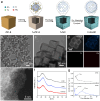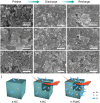Atomically Dispersed Ruthenium Catalysts with Open Hollow Structure for Lithium-Oxygen Batteries
- PMID: 37989893
- PMCID: PMC10663429
- DOI: 10.1007/s40820-023-01240-0
Atomically Dispersed Ruthenium Catalysts with Open Hollow Structure for Lithium-Oxygen Batteries
Abstract
Lithium-oxygen battery with ultra-high theoretical energy density is considered a highly competitive next-generation energy storage device, but its practical application is severely hindered by issues such as difficult decomposition of discharge products at present. Here, we have developed N-doped carbon anchored atomically dispersed Ru sites cathode catalyst with open hollow structure (h-RuNC) for Lithium-oxygen battery. On one hand, the abundance of atomically dispersed Ru sites can effectively catalyze the formation and decomposition of discharge products, thereby greatly enhancing the redox kinetics. On the other hand, the open hollow structure not only enhances the mass activity of atomically dispersed Ru sites but also improves the diffusion efficiency of catalytic molecules. Therefore, the excellent activity from atomically dispersed Ru sites and the enhanced diffusion from open hollow structure respectively improve the redox kinetics and cycling stability, ultimately achieving a high-performance lithium-oxygen battery.
Keywords: Atomically dispersed; Discharge product; Lithium; Open hollow structure; Oxygen battery.
© 2023. The Author(s).
Conflict of interest statement
The authors declare no conflict of interest.
Figures




References
-
- J. Xu, J. Ma, Q. Fan, S. Guo, S. Dou, Recent progress in the design of advanced cathode materials and battery models for high-performance lithium-X (X = O2, S, Se, Te, I2, Br2) Batteries. Adv. Mater. 29(28), 1606454 (2017). 10.1002/adma.201606454 - PubMed
-
- A.S. Arico, P. Bruce, B. Scrosati, J.M. Tarascon, W. Van Schalkwijk, Nanostructured materials for advanced energy conversion and storage devices. Nat. Mater. 4(5), 366–377 (2005). 10.1038/nmat1368 - PubMed
-
- K. Noah, L. Felix, M.K. Daniel, Energy storage deployment and innovation for the clean energy transition. Nat. Energy 2, 17125 (2017). 10.1038/nenergy.2017.125
-
- Y.Y. Birdja, E. Pérez-Gallent, M.C. Figueiredo, A.J. Göttle, F. Calle-Vallejo et al., Advances and challenges in understanding the electrocatalytic conversion of carbon dioxide to fuels. Nat. Energy 4(9), 732–745 (2019). 10.1038/s41560-019-0450-y
-
- W.J. Kwak, Rosy, D. Sharon, C. Xia, H. Kim et al., Lithium–oxygen batteries and related systems: potential, status, and future. Chem. Rev. 120, 6626–6683 (2020). 10.1021/acs.chemrev.9b00609 - PubMed
LinkOut - more resources
Full Text Sources
